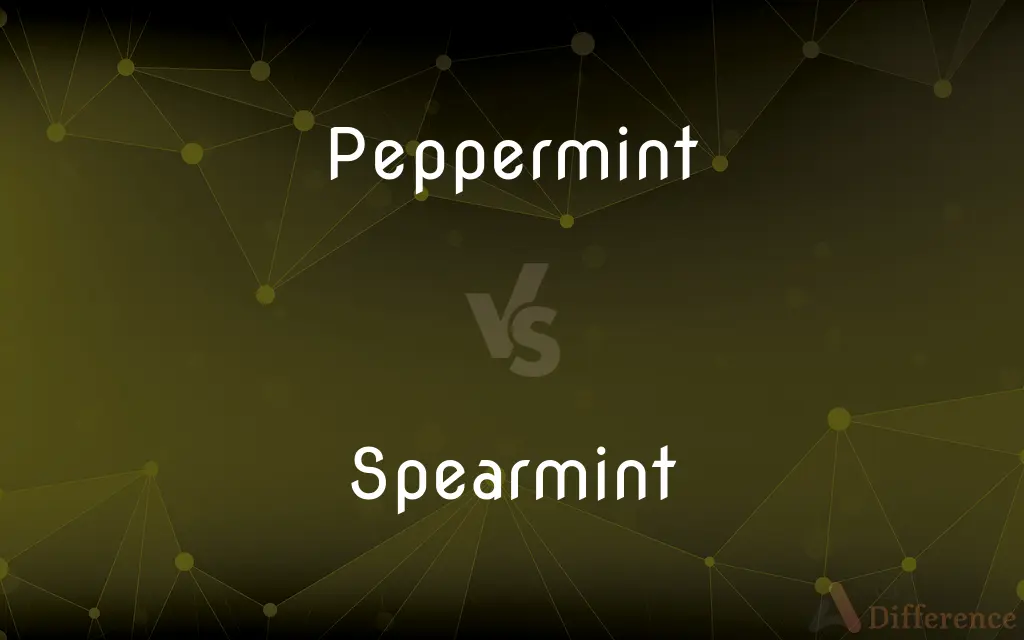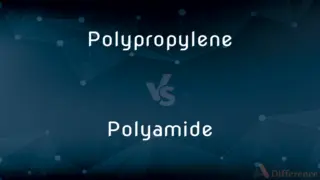Peppermint vs. Spearmint — What's the Difference?
By Fiza Rafique & Urooj Arif — Updated on March 8, 2024
Peppermint contains more menthol, offering a stronger, cooler flavor, whereas spearmint has a sweeter, milder taste.

Difference Between Peppermint and Spearmint
Table of Contents
ADVERTISEMENT
Key Differences
Peppermint, a hybrid mint from watermint and spearmint, is known for its high menthol content, which gives it a more intense and cooler flavor. Spearmint, on the other hand, contains less menthol, resulting in a sweeter and more subtle mint flavor. The leaves of peppermint are typically darker and may have a more crinkled appearance, while spearmint leaves are lighter green and smoother. This difference in leaf texture and color can help in distinguishing between the two.
Peppermint oil is widely used in the culinary, pharmaceutical, and cosmetic industries for its strong minty aroma and cooling properties. Spearmint oil, with its milder scent and flavor, is often preferred in dishes that require a gentler mint taste.
In terms of cultivation, peppermint generally requires more water and can be more sensitive to environmental conditions than spearmint, which is hardier and easier to grow in a variety of climates.
The health benefits of both mints are varied, but peppermint is particularly noted for its ability to relieve gastrointestinal issues, while spearmint has been traditionally used to aid digestion and reduce nausea.
Comparison Chart
Flavor
Strong, cool due to high menthol content
Sweeter, milder with less menthol
ADVERTISEMENT
Leaf Appearance
Darker green, crinkled
Lighter green, smoother
Uses
Culinary, pharmaceutical, cosmetics
Culinary, especially in dishes and teas
Oil Characteristics
Intense, cooling
Gentler, sweeter scent and flavor
Cultivation
Requires more water, sensitive to environment
Hardier, adaptable to various climates
Compare with Definitions
Peppermint
Used in candies and toothpaste for its cooling effect.
Peppermint-flavored toothpaste leaves a refreshing cool sensation.
Spearmint
A mint variety with a sweet, mild flavor.
I prefer spearmint gum because it's not as intense as peppermint.
Peppermint
A hybrid mint variety with a strong, cool flavor.
Peppermint tea is a popular remedy for stomach aches.
Spearmint
Characterized by lighter green, smoother leaves.
The spearmint in the herb garden can be identified by its smooth leaves.
Peppermint
Can relieve gastrointestinal discomfort.
I drank peppermint tea to ease my indigestion.
Spearmint
Often used in culinary dishes for a subtle mint taste.
I used fresh spearmint leaves to enhance the flavor of the salad.
Peppermint
Dark green, crinkled leaves.
The peppermint plant in my garden has distinctively dark and crinkled leaves.
Spearmint
Traditional remedy for digestion and nausea.
Spearmint tea can help soothe stomach discomfort and reduce nausea.
Peppermint
Essential oil used in aromatherapy.
Peppermint oil is often used in aromatherapy for its invigorating properties.
Spearmint
Preferred in cocktails and beverages for its mild flavor.
A sprig of spearmint is the perfect garnish for a refreshing mojito.
Peppermint
Peppermint (Mentha × piperita, also known as Mentha balsamea Wild) is a hybrid mint, a cross between watermint and spearmint. Indigenous to Europe and the Middle East, the plant is now widely spread and cultivated in many regions of the world.
Spearmint
Spearmint, also known as garden mint, common mint, lamb mint and mackerel mint, is a species of mint, Mentha spicata, native to Europe and southern temperate Asia, extending from Ireland in the west to southern China in the east. It is naturalized in many other temperate parts of the world, including northern and southern Africa, North America and South America.
Peppermint
A hybrid perennial plant (Mentha ×piperita) in the mint family, having small purple or white flowers and downy leaves that yield a pungent oil used as a flavoring and in some medicinal preparations.
Spearmint
An aromatic Eurasian plant (Mentha spicata) in the mint family, having clusters of small purplish flowers and yielding an oil used widely as a flavoring.
Peppermint
A candy or lozenge flavored with oil from this plant.
Spearmint
A herb of the mint family (Mentha spicata), commonly used in herb tea, candy and to treat mild stomach ache.
Peppermint
A hybrid herb of the mint family (Mentha × piperita), formed by crossing watermint and spearmint, which has a high menthol content and a sharp flavor and is used in cooking, especially in herb teas and in confections.
Spearmint
A species of mint (Mentha viridis) growing in moist soil. It vields an aromatic oil. See Mint, and Mentha.
Peppermint
(countable) A confection containing extract of peppermint.
Spearmint
Common garden herb having clusters of small purplish flowers and yielding an oil used as a flavoring
Peppermint
An aromatic and pungent plant of the genus Mentha (Mentha piperita), much used in medicine and confectionery.
Peppermint
A volatile oil (oil of peppermint) distilled from the fresh herb; also, a well-known essence or spirit (essence of peppermint) obtained from it.
Peppermint
A lozenge of sugar flavored with peppermint.
Peppermint
Herb with downy leaves and small purple or white flowers that yields a pungent oil used as a flavoring
Peppermint
Red gum tree of Tasmania
Peppermint
A candy flavored with peppermint oil
Common Curiosities
Can peppermint and spearmint be used interchangeably in recipes?
While they can be substituted for each other, the flavor profile of the dish will change due to their differing menthol contents.
Can I grow peppermint and spearmint in the same garden?
Yes, but they can be invasive and may cross-pollinate, affecting the purity of their flavors.
What is the main flavor difference between peppermint and spearmint?
Peppermint has a stronger, cooler flavor due to higher menthol content, while spearmint is sweeter and milder.
Is spearmint or peppermint more popular in culinary uses?
Spearmint is often preferred for its milder flavor in culinary dishes, while peppermint is used in more intense flavor applications like candies and toothpaste.
Are peppermint and spearmint leaves different in appearance?
Yes, peppermint leaves tend to be darker and more crinkled, whereas spearmint leaves are lighter and smoother.
What are the environmental needs for growing peppermint?
Peppermint generally requires moist conditions and may not tolerate extreme heat or drought well.
How does the menthol content affect the use of peppermint in products?
High menthol content makes peppermint ideal for products requiring a cooling sensation, such as muscle pain relief creams.
Which mint is better for digestive issues?
Peppermint is widely recognized for its effectiveness in relieving gastrointestinal problems.
Are there any health benefits unique to peppermint?
Peppermint is particularly noted for its cooling effect and ability to relieve nausea and headaches.
How does spearmint affect the digestive system?
Spearmint is traditionally used to aid digestion and reduce nausea without the intense cooling effect of peppermint.
What is the best way to store fresh peppermint and spearmint leaves?
Fresh leaves should be wrapped in a damp paper towel and stored in a plastic bag in the refrigerator.
Can either mint be used in making tea?
Yes, both peppermint and spearmint can be used to make herbal teas, with the choice depending on the desired flavor intensity.
Why is peppermint oil used in aromatherapy?
Its strong, invigorating scent and cooling properties make it ideal for stimulating the senses and providing relief from congestion.
Can peppermint be harmful if consumed in large amounts?
Yes, in large quantities, peppermint can cause heartburn or an allergic reaction in some individuals.
Is there a nutritional difference between peppermint and spearmint?
Both are low in calories and contain similar amounts of vitamins and minerals, but the essential oil compositions differ significantly.
Share Your Discovery

Previous Comparison
Dog vs. Fox
Next Comparison
Polypropylene vs. PolyamideAuthor Spotlight
Written by
Fiza RafiqueFiza Rafique is a skilled content writer at AskDifference.com, where she meticulously refines and enhances written pieces. Drawing from her vast editorial expertise, Fiza ensures clarity, accuracy, and precision in every article. Passionate about language, she continually seeks to elevate the quality of content for readers worldwide.
Co-written by
Urooj ArifUrooj is a skilled content writer at Ask Difference, known for her exceptional ability to simplify complex topics into engaging and informative content. With a passion for research and a flair for clear, concise writing, she consistently delivers articles that resonate with our diverse audience.
















































